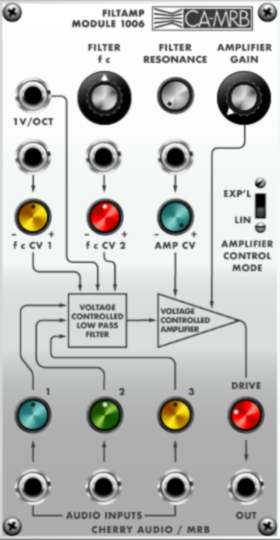
The 1006 Filtamp module is ARP's take on the classic 24 db/oct transistor ladder filter, combined with a VCA. It has the "fat" sound associated with this design and rich overdrive characteristics when its VCA Drive knob is pushed.
Inputs, Outputs, and Controls
1V/Oct jack- Accepts a CV input for scaling the cutoff frequency to match ascending notes. Typically this would come from the Pitch jack in the IO Panel CV Out section, or from a sequencer CV out.
Cutoff Frequency- Sets the cutoff frequency. Since this is a low-pass filter, all frequencies lower than this value will be allowed to pass through the filter while frequencies higher than the cutoff will be attenuated at a rate of 24db per/octave.
Filter Resonance- Turning this knob up emphasizes sound energy at and around the cutoff frequency by adding feedback from the filter’s output back to its input. With higher settings, modulation of the cutoff frequency becomes more pronounced and the filter will go into self-oscillation. Filter Resonance can cause loud squelches at high settings, so be careful.
Amplifier Gain- This is an initial gain setting for the voltage-controlled amplifier. Typically this will be set to zero, as the VCA level will usually be controlled by an envelope. Opening it up is useful for drones, or when setting pitches on a sequencer.
f c (frequency) CV 1/2 jack and attenuator- These are CV input jacks and attenuators for externally controlling cutoff frequency. Both jacks can be used simultaneously. The attenuators are bipolar - center position is zero; turn right for positive CV or left for inverted (negative) CV values.
Amp CV jack and attenuator- Controls VCA amplitude. Typically, you'll patch the output of an envelope generator to this input. The attenuator is bipolar - center position is zero; turn right for positive CV or left for inverted (negative) CV values.
Amplifier Control Mode / Exponential/Linear - These select the curve of the amplifier's response as the input CV rises from 0 to 5V. Lin or linear response curve is equally proportional across the voltage input range, whereas an exponential (Exp'l) curve is closer to how the human ear perceives volume. With that in mind, you'll likely want to use the Lin setting for modulation or control voltage situations, and use the Expo setting when an envelope generator is used to control the shape of an audio signal.
Input jack and attenuator 1/2/3- Patch audio signals in here. These essentially act as an input mixer for signals.
Drive- Adds warm overdrive to the signal by overdriving the internal VCA. Though the original 2500 module didn't have a drive control, its VCA inherently distorted a bit and the default setting of 32% accurately reflects this. Independent of VCA Drive distortion, the 1006 Filtamp can also be overdriven by patching a hot input signal.
Output jack- Audio signal output.